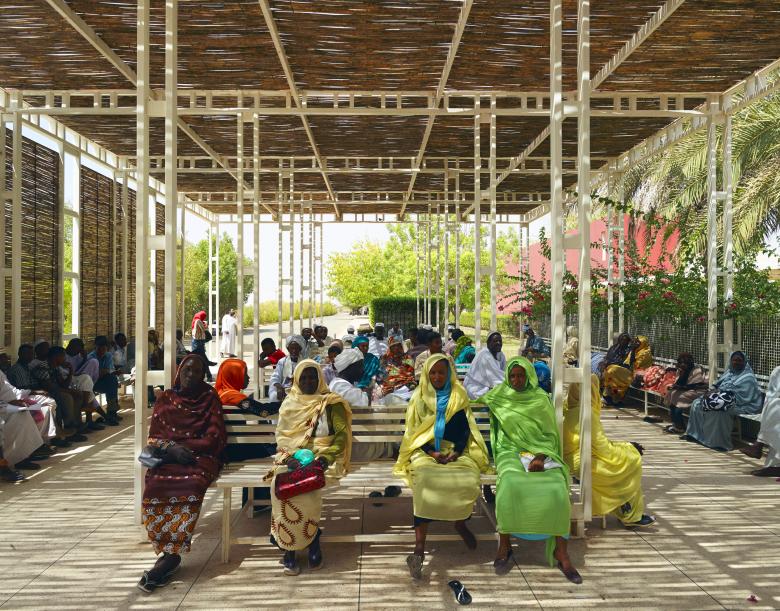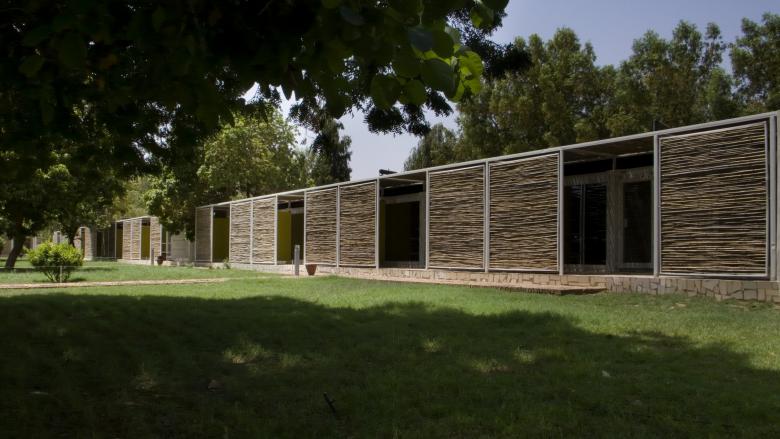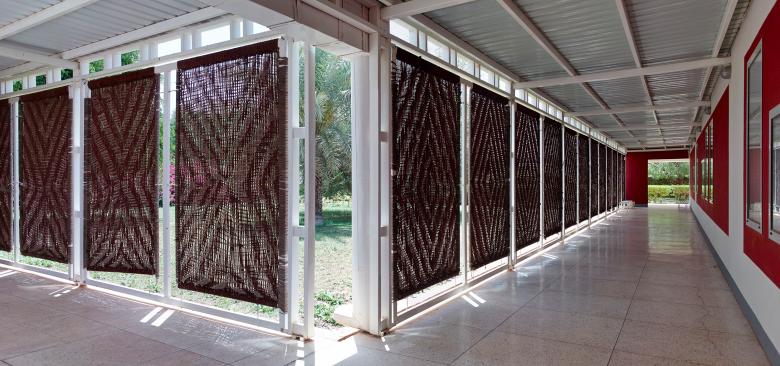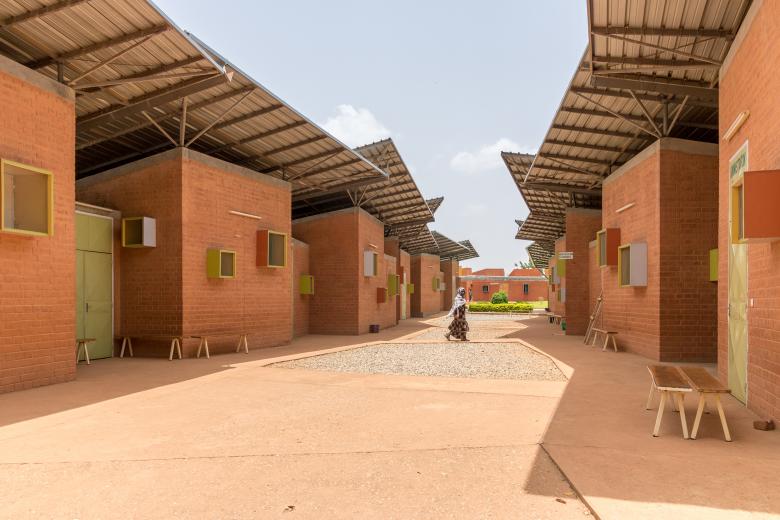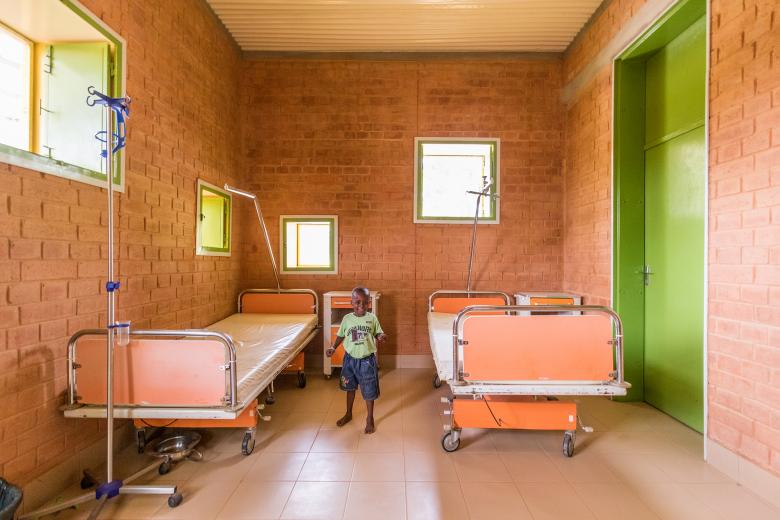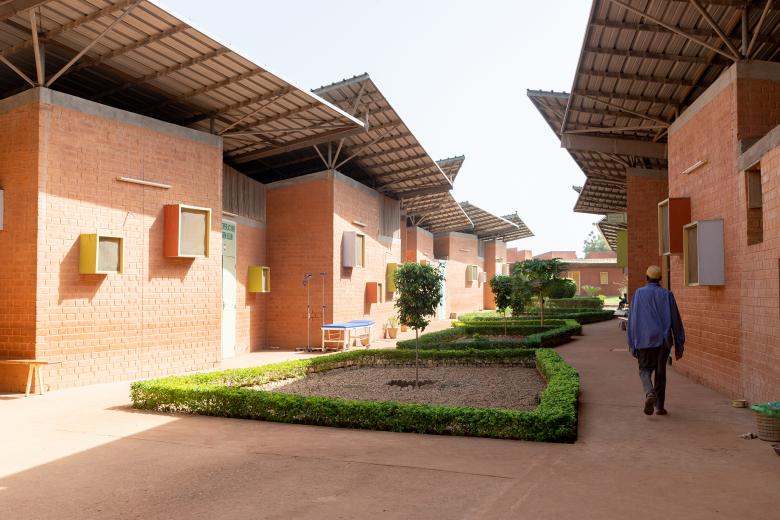Mastering Global Challenges with Hospital Architecture
Susanna Koeberle
5. February 2024
The Salam Centre for Cardiac Surgery by TAMassociati is located in the south of Khartoum (Sudan). The picture shows the hospital's waiting area. (Photo: AKAA/Cemal Emden)
Three examples from Africa show how architecture can respond to crises. The African continent is particularly affected by the impacts of climate change as well as poverty and associated diseases. At the same time, crucial decisions are being made in such places.
Globally, a paradigm shift is taking place in hospital architecture, linked, among other things, to a new sensitivity to the diverse challenges of construction in times of the climate crisis. It is also due to technical and organizational reasons that this building typology is one of the most complex construction tasks of all. Moreover, it is important to find aesthetically pleasing solutions for the large building volumes and the flexibly designable spatial programs—in other words, to create spaces where people enjoy staying and can recover. However, hospitals are more than architectural structures; they are also indicators of societal and political conditions and developments. While these vary from region to region, the awareness that many current problems are interconnected beyond national borders has increased in the last decade. In this regard, we are also in a process of transformation.
One of the entanglements between different geographical zones is the issue of colonialism; the effects of this historical period are only now being recognized and explored in their full extent—thanks to Lesley Lokko, also in architecture. The curator of this year's Architecture Biennale placed the themes of decolonization and decarbonization at the center of her curatorial approach. In her Laboratory of the Future, the African continent and the African diaspora played a central role. Lokko's Biennale directed long-overdue attention to a region and its diverse cultures that have been dreadfully neglected: Because even though Africa makes up twenty percent of the total land area of our planet, there is still much to be done in terms of architectural historical accounting of the past. We all know the pyramids. But what about the rest? Here is a gap, a void. This situation says a lot about the perspective from which the history of the African continent has been told so far. And it shows that a large part of humanity has been excluded from a discourse. The history of architecture is not wrong, but incomplete, says the Ghanaian-Scottish architect, academic, and novelist.
The exterior view already shows the multi-layer principle of the building. (Photo: TAMassociati)
This prompted us to present three projects from Africa as part of the contribution Healing architecture. Focus international. This does not mean that there are no groundbreaking and innovative hospitals being built in the USA, South America, or Asia. However, the Global South is struggling with serious problems in the healthcare sector. The fact that many African countries are particularly affected by diseases is also related to the lack of a comprehensive healthcare system. This, in turn, is partly due to rapid population growth. In most of the 54 African states, poverty is widespread, and many people have no access to medical care—and sadly, also no access to drinking water, sanitation, or electricity.
This contradicts the fact that Africa is rich in resources. However, this wealth does not reach the poor. Poverty, hunger, and diseases are exacerbated not least by climate change, the effects of which are felt particularly drastically in the Global South. In addition, most of the crisis regions are located on the African continent, forcing many people to flee—mainly within the continent. Overall, the prospects are not rosy. All the more reason to highlight projects that face these numerous challenges. And by doing so, they not only alleviate the suffering of Africa's health-stricken population but also stand out as exemplary healthcare buildings from an international perspective.
When designing a hospital in this climate zone, heat proved to be the major challenge. (Photo: AKAA/Cemal Emden)
Due to often unstable governmental structures and rampant corruption, many hospital construction projects in Africa are initiated by private organizations. This was the case with the Salam Centre for Cardiac Surgery in the soutsh of Khartoum (Sudan) by TAMassociati. The Sudanese government now supports the cardiac surgery center, which provides highly specialized assistance for patients with cardiovascular diseases. The clinic consisting of several buildings was inaugurated in 2007, and health care is provided for free.
The Venetian office has been collaborating with the Italian humanitarian organization Emergency since 2004 and has designed several health centers in Sudan. In mid-April 2023, intense fighting broke out in Khartoum between the army and a paramilitary militia, expanding throughout the country. This further complicated access to medical facilities. The NGO promptly responded, set up a network of satellite clinics, and opened a hospital for trauma and accident surgery within the existing cardiac surgery complex in August 2023 to treat victims of the conflict.
When designing a hospital in this climatic zone, heat proved to be the greatest challenge. Temperatures in sub-Saharan countries can rise to fifty degrees, requiring a good and energetically sensible solution for cooling the premises. The architects addressed the frequent sandstorms in the region with a clever air filtration system. According to Raul Pantaleo, co-founder of the architectural firm, their main question in the design process always was: "What do we really need?" To protect the buildings from external influences, the masonry consists of two layers. Insulation is provided by a multi-layer system of 5 cm thick insulation panels on the inside and an outer shell of a ventilated metal roof and bamboo blinds. A solar system supplies the hot water system. A central aspect that had to be considered in the design phase was keeping the costs down regarding subsequent operating expenses.
Despite all these parameters, the first message the team wanted to convey to the center's patients was beauty; and that these people are considered to be equals, says the architect. Caring for aesthetic details— including the integration of plants on the premises—can contribute to the healing process. Although the word beauty may sound like a luxury given the extreme conditions in Sudan, it shows that this is a common feature of a building typology oriented towards human dignity. From this perspective, the location where this building stands would only have a secondary influence on the design. Only through this prioritization can architecture become an instrument of care.
The ten modules of the Surgical Clinic and Health Center are laid out like a village along a street. (Photo: Andrea Maretto for Kéré Architecture)
This principle also seems to be close to the heart of architect Diébédo Francis Kéré, born in Burkina Faso in 1965. His Berlin-based office is dedicated to designing sustainable buildings constructed using local materials and labor. Kéré, honored with the Pritzker Prize in 2022, also applied this principle to his new hospital in Léo, Burkina Faso, which was completed in 2014. The main objective of the project was to relieve the existing district hospital and meet the medical needs of the population; the hospital is equipped with surgical facilities, an inpatient ward, and a maternity ward. Accommodations for doctors were added in 2018.
The surgical clinic, which was built thanks to the support of the non-profit association Operieren in Afrika e. V., is more than a health center. Here, architecture represents the principle of cooperation. During the construction phase, the clinic served to train local craftsmen; after completion, international specialists work on short assignments, training local doctors and nurses in the process.
Surgical Clinic and Health Center (Photo: Andrea Maretto for Kéré Architecture)
The complex consists of ten modules arranged like houses in a village along a central street, creating a familiar environment. This interpretation of traditional urban structures is complemented by the use of local materials, skills, and ecological strategies. The walls are built from sun-dried clay bricks, whose thermal mass facilitates temperature regulation in the interior. The ventilated double roofs provide protection from the sun by deflecting radiation, and a simple system collects rainwater for irrigating the surrounding trees. The cantilevered roofs shield the clay bricks from rain and direct sunlight. A formative aesthetic element are the colored, protruding wooden window reveals that give the entire complex a cheerful appearance.
Colorful accents and plants create a cheerful atmosphere. (Photo: Andrea Maretto for Kéré Architecture)
Although still under construction, the location of the Magdi Yacoub Global Heart Center in Cairo is already quite spectacular: from the hospital, one will be able to see the world-famous Pyramids of Giza. The architecture of the new 300-bed building—a collaboration between Foster + Partners and the company Dar—is also distinctive. The hospital adjoins an existing research center and is expected to be completed in 2025. This construction project is also backed by a private donor, namely the Magdi Yacoub Foundation. Their mission is to improve the health situation of the most vulnerable population groups, especially children, by providing advanced and free heart treatment.
The roof structures of the four buildings are inspired by feluccas, the typical sailboats on the Nile. A lush vegetation is intended to flourish around and in the middle of complex; the clinic itself was designed according to so-called biophilic design criteria. Given that Cairo, with 22.2 million inhabitants, is the largest African city, the expansion of the foundation's existing heart center in Aswan is more than a luxury but simply a necessity. The location near Cairo makes the clinic more accessible to a larger population. Accessibility is central when it comes to improving the often dilapidated health system on the African continent.
– The Path to Improved Quality of Stay in Hospitals: Economic Aspects of Hospital Planning
– Designing Healing Spaces: Focus Europe
Related articles
-
Centre des Cultures et Spiritualités Ewés
3 weeks ago
-
Inside ‘Tropical Modernism’
on 3/19/24
-
Between Tradition and Innovation
on 3/14/24
-
African Brutalism Is Trending
on 11/30/23
